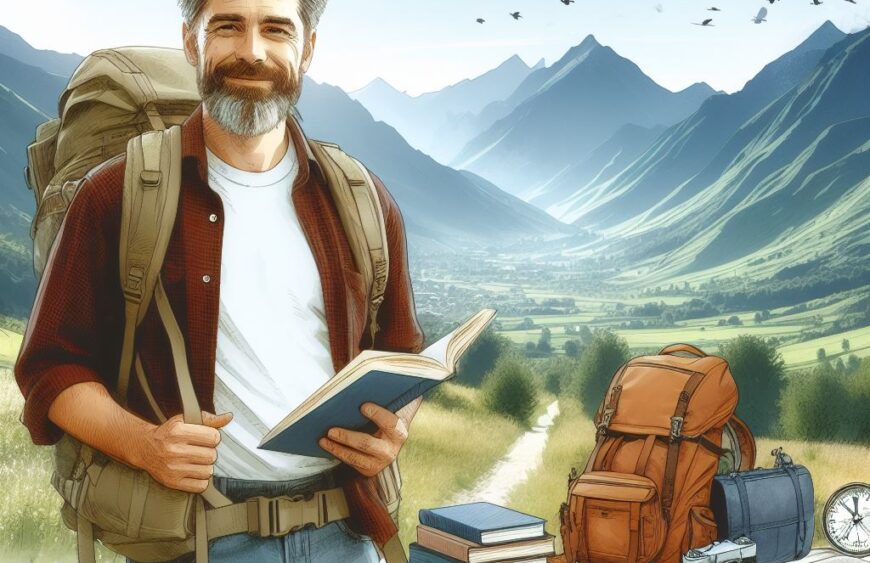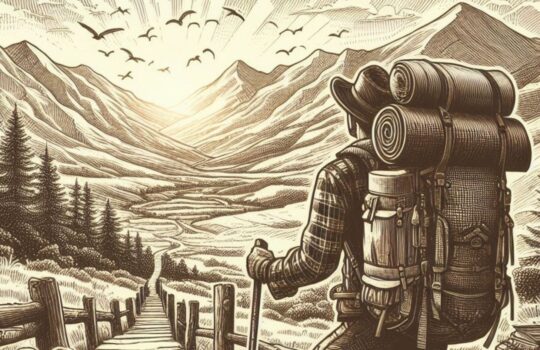Back in October, I had the pleasure of talking with Andrew McCloy, guidebook author, and self-confessed ‘ Jobbing Writer’ for major outdoor publications including TGO.
Listen to the full episode here
I’ve long wanted to get a guidebook author on the show, mainly because it selfishly interests me as an artistic exercise, but also because guidebook authors are in my opinion unsung heroes of the hiking community. It’s the inquisitive spirit behind a good guidebook that embellishes a trail with interest beyond a series of simple ‘cross the field, and turn left at the next stye’ style of instructions.
Well-written guidebooks bring the trail and its history to life in ways that most of us can be bothered to do so. Yet having a book we can pick up for a tenner, which has the back story, history and valuable inside information on a trail is a luxury. Hiking apps just don’t currently compare, and I hope that people like Andrew continue to write excellent guides.
But what does it take to become a guidebook Author?
Well, I asked Andrew, to find out what the job description entailed.
As with any profession which is not a route to riches (although I’m sure the founders of Lonely Planet disagree) enjoyment of the craft is key. But what attracts Andrew to writing guides is what he calls the ‘art form’ of writing. He explains that the attraction is in the fluent and artistic narrative, supported by “meticulous planning“. He enjoys the buzz when planning a new guidebook for a long-distance trail and enjoys the long ‘nights doing logistics’.
Essentially what underpins Andrews’s method of writing guidebook’s is not the finished result, (although I’m sure that’s wonderful) but the process itself. It’s the process that makes this profession exciting for Andrew.
If you have ever considered writing a hiking guidebook, the insights below may help you get started.
What’s the process of putting together a guidebook?
What I found interesting was the insight that guidebooks are not written in full the first time around. Instead, they are written in parts and walked in bits. Andrews’s first book, Lands End to John o Groats was put together over a number of trips, including weekends and holidays. He threaded the route together with long-distance paths, and filled the bits in between…
How does this turn into a full time career?
Ah, the 9-5 question. How do you leave your dull day job, and spend the rest of your days walking the hills while getting paid?
With enough savvy and a bit of healthy hustle most creative pursuits can be turned into a career. Andrew chucked as he shared his realisation that he could ‘scrape a living’ if he came up with enough ideas. Yet he was mindful that he always needs to be a step ahead, thinking of different slants on existing guidebooks.
He acknowledged that the Lake District for example probably is at full capacity for guidebooks, so thinking of something totally different is a must. Andrew laughed as he said, “I challenge everyone to find a new slant on a book on the Lake District“.
Opportunities for writing guidebooks exist in new and emerging gaps in the market (think how many ‘slow travel’ guides came out a few years ago), places people are talking about, or books that are going out of print.
Ultimately though Andrew shares that you should ‘not be afraid to ask people to take a chance on you’.
How do you get the detail to make it interesting?
Theres a big distinction between a boring guidebook and an interesting one. I’ve seen both.
Andrew keeps his guidebooks interesting by remaining curious and picking up clues from those he speaks with on the trail. For example, he will often stop at YHA’s and pubs to pick up parish newsletters and learn of local history groups, who are a source of valuable information.
When writing his Pennine Way book Andrew was particularly interested in Thomas Stephenson who originally walked the route. He made a point of going down to London to the archives at the London University to look for research and a deeper level of history on Thomas. This level of commitment gave life to the book.
Andrew says, “you have to put in the legwork and check the facts“. But he confessed, “When you are not sure you have to own up to it, and just tell the story anyway if it’s good”. A bit of creative bending of a story never goes too far wrong if done honestly.
What’s your view on walking apps?
I was curious to hear Andrews’s views on walking apps. After all apps and digital mediums have been seen as a threat to writing and physical mediums. Although books and records seem to have bucked that trend.
Andrew mentioned he does occasionally pick up apps and follow it, particularly for new places as it gives him confidence about where to go. However, he does come away feeling he can do better and provide better directions and clarity on the route.
How many guides have you written to date?
I’m keen to point out that Andrews’s success within his profession was not an overnight one. Success rarely is.
Andrew has written or contributed to just under 20 guides of various types. His more recent ones were a social history of the pubs in the Peak District, and of course, the book we talked about on the Podcast, Great Walks on the England Coast Path.
Kinder beer barrel challenge story
Any career highlights?
In 2015 Andrew celebrated his 50th Birthday. This nicely coincided with the Pennine Way also having its 50th anniversary that year. Andrew had “long harbored the desire to walk it all in one go“. Naturally, he wanted to follow this up with a publication – one that was personal to him.
He chose to focus on a different angle on the Pennine Way. After all, there are already a number of guides for this popular long-distance trail.
Andrews’s focus was to look at the social history, access, the history of the YHA on the route, footpath erosion, and of course his personal motivations for walking the path – using the way as a test against yourself.
Next steps
If writing a guidebook is of interest to you, my recommendation is this. Get out and write it.
Choose a suitable area. Perhaps somewhere less walked (how many walking guides exist for the Lincolnshire Wold’s for example?), or as Andrew says, find a different slant.
To help you on your way to guidebook writing glory, and a space next to Andrew and Alfred Wainwright here are some free ideas to get you going.
- A guidebook linking up pubs from lands end to John o Groats – making the UK’s biggest pub crawl.
- Modern pushchair hiking guides. Some exist but they are very aged now
- Long distance trails that can be walked in a weekend
- Themed guidebooks. For example, routes around the UK that tell a historic story of places involved in the English Civil War
- Premium walking guides for those who want to stay in fancy hotels, and eat fancy meals. Think the Thames Path for the top 1%
- Trail running guides – long distance walking guidebooks but designed for trail runners
You get the point. There are lots of angles for guidebooks that don’t involve writing yet another guidebook on the Hadrian’s Wall Path.
Hopefully you found this article helpful. Let us know what you think in the comments 👇





